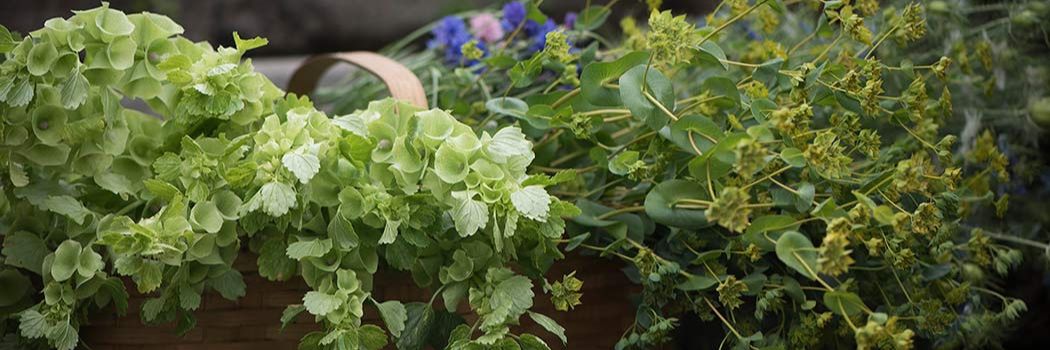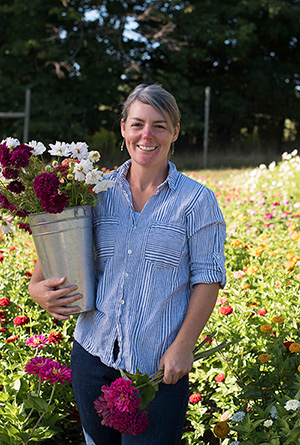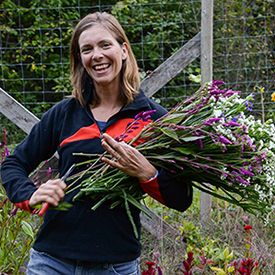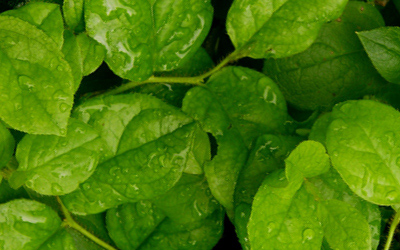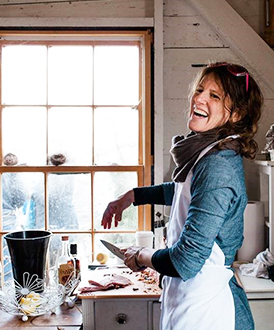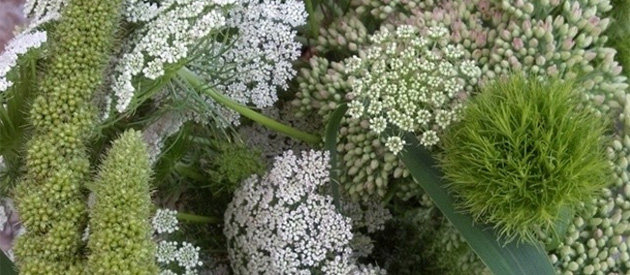- 3 Easy, Reliable, Productive Cut Flowers: Sunflowers, Zinnias & Rudbeckia
- 5 Factors That Determine Vase Life of Cut Flowers
- American Flowers Week: Combining the Art of Floral Design & Couture
- Celebrating the 8th American Flowers Week | Johnny's 2022 Botanical Couture
- Celebrate the 7th American Flowers Week | Johnny's 2021 Botanical Couture
- Collective Selling Models for Flower Farmers: Flower Hubs That Work
- 5 Cool Flowers to Plant Now | Lisa Mason Ziegler's Secrets for Growing Hardy, Cool-Season Annuals
- Cut-Flower Harvesting & Post-Harvest Care | Best Practices from Pros in the Slow Flower Community
- Cut-Flower Kit | Guide for Market Growers (PDF)
- Easy Cut-Flower Garden Map | For Growers New to Flowers (PDF)
- Easy Cut-Flower Garden Planner | For Growers New to Flowers (PDF)
- From Color to Climate: 5 Floricultural Trends Subtle & Seismic
- Flower Culture by Crop | Comparison Chart | Days to Germination, Weeks to Transplant, Days to Harvest (PDF)
- Flower Farmers' Favorite Fillers & Foliage | Recommendations from 3 Farmer-Florists
- Getting Started in Cut-Flowers | Top 15 Cuts
- Heat & Drought: How Flower Farmers Are Adapting to Changing & Challenging Climatic Conditions
- Intro to Overwintering Flowers | Method & Recommendations from Johnny's Overwinter Flower Trials
- An Introduction to Producer Marketing Cooperatives | M Lund & Associates
- How Day Length Affects Cut-Flower Production
- Flower Power for Roadside Markets
- Growing Flowers in Hoophouses & High Tunnels: Some Cool-Weather & Hot-Weather Options
- Tips for Starting a U-Pick Flower Operation
- Year-Round Flower Production Strategy
- Overwinter Flower Trials | Multiyear Results for >25 Crops | Johnny's Selected Seeds | XLSX
- Seeding Date Calculator | Johnny's Recommended Flowers for Overwintering | XLSX
- Just Add Flowers | An Introduction to Companion Planting for Vegetable & Herb Gardeners
- Sustainable Farming Methods | A Survey of Flower Farmers' Best Practices
- Pricing & Profitability for Flower-Farmers | Pointers from a Diversity of Pros
- Slow Flowers Palette & Petal Crushes | Evolving Colors & Shape-Shifts in Floral Industry Trends
- Johnny's & Slow Flowers | Johnny's Selected Seeds
- Slow Flowers | Celebrating Fifth-Season Regional Design Elements
- Slow Flowers Floral Forecast | A Summary of Industry Insights & Trends
- Slow Flowers | Building a Better Market Bouquet | Tips & Techniques for Flower Farmers
- Slow Flowers | Tips for Staging On-Farm Floral Workshops | Johnny's Selected Seeds
- Wedding Wisdom 101 | 10 Beginner Tips for Entering the Wedding Floral Landscape
- Succession-Planting Flowers | Scheduling & Planning, Sowing Frequency, Recordkeeping & Recommendations
- Succession-Planting Interval Chart for Flowers
- Sustainable Floral Design | Techniques & Mechanics for Foam-Free Floristry | Tobey Nelson & Debra Prinzing
- Video: Mason Jar Bouquet Tutorial
- Video: How to Build a Bouquet
- Video: Tobey Nelson | Sustainable Floral Design | Slow Flowers Summit
- Video: Economic Considerations in Overwintering Cut Flowers | Johnny's Selected Seeds
- Floral Stem Cutter | Instructions for Mounting, Use & Care | Tech Sheet (PDF)
- Top-10 Flowers for Direct-Seeding | 5 for Cool-Soil Sowing + 5 for Warm-Soil Sowing
- Video: Floating Row Cover | Baby "Cool Flower" Protection from Whipping Winter Winds
- Video: The Procona System for All-in-one Flower Harvest, Transport & Display
- Johnny's Overwinter Flowers Tunnel: Trellising, Supports, Ground Cover & Spacing
- Video: Irrigation Considerations for the Overwinter Flowers Tunnel | Johnny's Selected Seeds
- Video: Johnny's Overwinter Flowers Trial Recap
- Video: Producer Cooperatives for Small-Scale Farmers | Johnny's Webinar Series
- Climate Adaptation for Vegetable & Flower Farmers | Johnny's Educational Webinar Resources
- Webinar Slide Deck | Flower Growing in Southern States | PDF
- Bloom to Boom: Flower Farm Profitability
- Chrysal Professional 1 Hydration Solution | SDS
- Chrysal Professional 2 Transport & Display T-Bag | SDS
- Eat Your Flowers: Serve Up That Wow Factor With Edible Flowers
- Forcing Tulip Bulbs
- When to Start Seeds for Overwintered Flowers
- Introduction to Forcing Flower Bulbs in Soil
- Chrysal Clear Bulb T-Bag | Cut-Flower Conditioner | SDS
- Flower Growing in Southern States | Johnny's Educational Webinar Series
- Chrysal CVBN Flower Conditioner | SDS
- Video: Flower Growing in Southern States | Johnny's Webinar Series
- Chrysal Clear Universal Flower Conditioner | SDS
- Chrysal Clear Bulb Flower Conditioner | SDS
- Choosing Tulip Varieties for Forcing
- 10 Tips for Building a Profitable Cut-Flower Business
- Edible Flowers List: Top 20 Favorites from the Slow Flowers Community
- Choosing Flower Crops to Overwinter: Results from Our Trials
- Webinar Slide Deck | New-for-2023 Flowers & Floral Supplies | PDF
- Chrysal Classic Professional 2 Transport & Display (Holding) Solution | SDS
- Flowering in the South: Profiles of 5 flower farmers who cope with temperature, humidity, pest & weed pressure
- Chrysal Professional 3 Vase Solution Powder | SDS
Fillers & Foliage: Flower Farmers Share Their Favorites
Recommendations & Tips from 3 Farmer–Florists
by Hillary Alger, R&D, Flower Products Manager
ON THIS PAGE
- Fillers & Foliage: The backbone of floral arrangements
- Raindrop Farms
- Broadturn Farm
- B-Side Farm
- Hillary's Favorites
The Backbone of Floral Design
Both in commercial cut-flower production and in the backyard cutting garden, fillers and foliage form the backbone of cut-flower arrangements.
In addition to providing structure and bulk, they lend design elements which, while less obvious, are as critical in most arrangements as the flowers. They give arrangements a lush, full, and balanced appearance, often offer background color, and tie together all the blooms. Perhaps underappreciated by the casual observer, fillers and foliage are the workhorses of bouquets and indispensable in the cut-flower garden or shop. More often, fillers and foliage make up the larger proportion of material in any given bouquet, so the best ones are easy to grow or source, abundant, dependable, sturdy, and beautiful.
Because we often get questions on this topic, I've asked flower farmers from three different regions who grow, design, and market their blooms for some recommendations and tips. Here's what they have so generously shared with us — followed by a few of my favorites!
PACIFIC NORTHWEST • Rain Drop Farms, Philomath, Oregon
Erin McMullen, her husband Aaron Gaskey, their two boys and Roscoe, the farm dog, grow over 60 types of cut flowers on 3 acres of their farm in the Willamette Valley. Starting out with an ambitious backyard garden, they've been growing now for over 15 years. Erin and Aaron love to share what they've learned along the way.
Especially if you're just starting out, they recommend selecting crops that are both easy to grow and versatile for different market types, from the roadside stand to bridal bouquets.
Erin's Favorite Foliages & Fillers
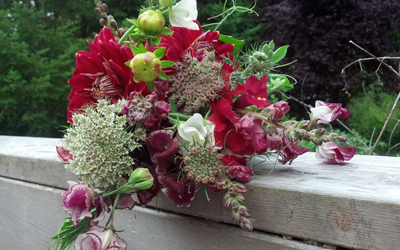
Feverfew (Matricaria) & Statice
Both statice and feverfew hold up well for us at the farmer’s market, make a bouquet look and feel full, are super easy to grow, and continue to produce over a long period of time — though we do succession-plant to guarantee fresh blooms throughout the season.
Bells of Ireland
Image courtesy of Northwest Native Plants Database
Bells of Ireland has such a unique color, and a great arching habit that makes it a must-grow crop for our floral designs.
Raspberry Foliage, Ferns, Scented Geranium & Salal
Raspberry foliage, salal, scented geranium and ferns are all great "greenery" for laying the foundation for all types of bouquets.
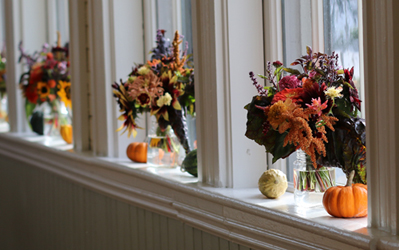
Ammi
Ammi gives bouquets an airy look and delicate detail. We love using it!
Sedum
We use sedum throughout all its stages — green, pink, brown. It lasts forever and makes a great foundation.
Amaranth & Broom Corn
Amaranth and broom corns are indispensable in fall bouquets, but both can be used throughout the season to add interesting shape and texture to bouquets.
… so many things that are great!
Connect with Rain Drop Farms
NORTHERN NEW ENGLAND • Broadturn Farm, Scarborough, Maine*
Farming in Maine since 2002, Stacy Brenner lives, farms, and flowers at Broadturn Farm with her husband John Bliss and two daughters, Emma and Flora. They raise cut flowers and organic vegetables, host weddings, and operate a summer day camp that focuses on connecting a young community with where nutritious and sustainable food comes from.
Stacy's Favorite Spring & Summer Foliages & Fillers
Note: Johnny's recommendation to direct-seed early is based on bupleurum disliking hot temps. Broadturn is able to be successful with the above protocol by keeping the transplants cool in the greenhouse.
Annuals
Spring: Bupleurum 'Green Gold'
A wonderful first flush of foliage to use in arrangements with peonies. Started in the greenhouse, the first succession of bupleurum transplants go out into a high tunnel as early as possible. We plant them 6x6 in well-amended beds. Successions of bupleurum are started every 2–3 weeks.
Summer: 'Mountain Snow' (Euphorbia marginata)
One of my favorite fillers grown from seed. This euphorbia has a nice long vase life if hydrated rapidly after harvest. Also, mid-summer foliage does well if the field heat is removed as quickly as possible.
One caveat: Some of us on the farm have a reaction to the sap produced when the plant is cut, prompting the donning of gloves during harvest and bouquet making. The end result is worth it, and customers rave over the charming variegated green foliage.
We grow multiple successions, seeded in 128-cell flats at 3–5 seeds per cell, planted out at 6x6-inch spacing. We plan and plant the last succession to produce its diminutive white blossoms just prior to the frost.
Herbaceous Perennials
Spring: Lady's Mantle (Alchemilla mollis)
Our 75'-long bed of Lady's Mantle pumps out a sweet, useful filler for a few weeks each spring. This perennial for us is long lived, and the initial investment of bare-root starts has more than paid off.
Summer: Mountain Mint (Pycnanthemum muticum) and Baptisia australis
Mountain mint and baptisia are both long-lasting herbaceous perennials in our rotation. We can't get enough of either of them, and continue to increase our plant stock of both. We cut two-thirds of the baptisia blooms in early spring, leaving a third behind for the interesting seed pods to develop for later harvest. Then, over the course of the summer, we harvest two-thirds of the foliage from all the plants, with the remaining third to be cut immediately prior to the first frost in the fall. We use the baptisia seed pods to add interest to fall arrangements.
* Stacy has been elected to the Maine Senate since the writing of this article! Connect with Broadturn Farm:
SONOMA COUNTY • B-Side Farm, Sebastopol, California*
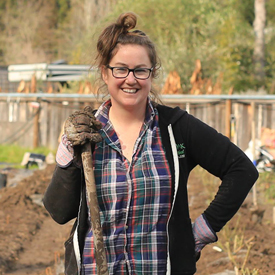
Lennie came to farming and flowers from a background in social work and adult education. Naturally, B-Side Farm has quickly become an educational farm where Lennie not only grows and designs with flowers, but teaches others how she's doing what she's doing. B-Side Farm workshops are designed to meet every student on their own plane and encourage them to delve a little deeper into the world of flowers — whether in the garden or design studio. The B-Side Blog is a growing resource for both of these arenas.
Lennie's Favorite Foliages & Fillers
I rely heavily on foliage to create the loose, sprawling, wild look I'm after. In any given wedding arrangement, I'll be satisfied if I include three different types of foliage — but I'd be even happier with five!
I'm always re-thinking the varieties of foliage I grow, buy, and forage by judging them on two virtues — first, being easy to find, and second, providing something unique and of interest in the design. The ideal will have some small leaves, some big ones, some thin arching stems, and some more sturdy. In other words, the more variety across the board, the better.
Basil 'Cinnamon' or 'Aromatto'
I love these basils for how well and how long they hold up, and the heft as well as gentle curves they add to arrangements. It's so nice to grow so much bulk from an annual seeded crop. The purple is stunning and can either accentuate a purple color scheme or easily blend with other colors.
Bupleurum
So easy to grow from seed (as long as you remember that it needs dark to germinate!), bupleurum is one of those crops I'd be smart to succession-sow every week or two on the farm. It adds such great movement to arrangements and it just SHINES!
California Bay Laurel
In my area, bay laurel is abundant, and it's been easy to connect with local ranchers who will let me sustainably forage it from their properties. It makes a great base for many arrangements, and has been key in making garlands.
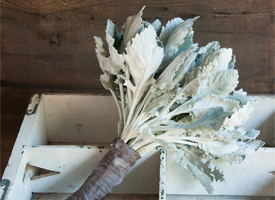
Dusty Miller 'New Look'
As long as I start this early enough, by mid-summer I've got enough hardened-off stems to use in nearly every wedding. Dusty Miller 'New Look' holds up really well, adds a touch of softness to arrangements, and is a great way to bring in that silvery-gray that so many customers are looking for.
'Frosted Explosion' Ornamental Grass
Do you ever have chicken wire or other mechanics showing through an arrangement when you thought it was complete? Me, too! 'Frosted Explosion' is my secret answer to this problem, and can be tucked into an arrangement on completion, to take up space, mask holes, and provide a touch of glimmer.
Olive Foliage
Olive is another shrub that is easy to grow and cut in my region. For large arrangements, arches, arbors and urns, it comes in handy every time and adds a bit of grace. I like to pretend I'm living on a Tuscan villa and just surround myself in huge swaths of it.
* Lennie has relocated to Warren, Oregon since the writing of this article! Connect with B-Side Farm:
Recommendations from Hillary
A few more favorites…
- Atriplex. Color and texture especially suited to moody, late summer and fall arrangements with red and bicolored sunflowers and salmon colored zinnias. Mature, sturdy stems hold indefinitely in bouquets.
- Celosia. Plume (plumosa) types are productive and long-lasting for summer and fall bouquets.
- Dill. Easy to grow. Makes bouquets sparkle like filtered summer sunlight.
- Eucalyptus. Requires a long period (10–12 weeks) for seedling development, but by late summer can be quite productive for fall or winter arrangements and wreaths.
- Mint. Adds wonderful scent and holds up well in bouquets if cut when plants are mature and stems appear woody at the base.
- Orlaya. Similar in appearance to Ammi but a bit more delicate, with the outer row of petals putting on a show.
- Rosemary. Too precious to use in most market bouquets but adds scent and detail to arrangements for special occasions.
- Saponaria. An airy early-season filler with a delicate look and sturdy stems.
- Sage. Early, sturdy foliage from the perennial garden adds that gray-green color that is so popular.
- Yarrow. Sturdy, dependable, and holds very well in bouquets if cut when blooms are mature and pollen is visible. It's tempting to grab those first blooms early, but they will wilt if cut too early.


